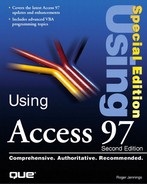Understanding Microsoft's View of Databases and the Web
Giving away Web browsers, including Web servers with Windows NT Server 4.0, and distributing free Internet enhancements for browsers and servers isn't a business model that's likely to add much to Microsoft's bottom line. To earn a return on its Internet investment, Microsoft ultimately must sell, not give away, products. The initial objective of Microsoft's Internet program is to increase sales of Windows NT Server 4.0 as an Internet/intranet server and to make SQL Server 6.5+ the client/server database of choice for conducting Internet commerce and distributing information from corporate databases over private intranets. Data marts, data malls, and distributed transactions are the keys to Microsoft's success in the back-end of the Internet/intranet business.
Rolling Up Data to Marts and Malls
Most large organizations have established or plan to establish intranets that let networked users of Web browsers query data that is stored in databases running on mainframes or minicomputers. Letting users run queries directly against these business-critical transaction databases is an anathema to the vast majority of information services managers. Data warehouses make organization-wide information available without disturbing day-to-day database operations.
Periodically, data from the transaction databases is downloaded, often in summarized form (called rollups), to a client/server data warehouse. Smaller data marts, which hold up to about 250G of data, serve individual divisions or departments. Data malls consist of groups of data marts against which users can execute distributed queries. A distributed query can create joins between databases running on separate data mart servers. Data marts and malls are ideal applications for SQL Server 6.5 running under Windows NT Server 4.0. Microsoft doesn't give Windows NT Server or SQL Server away; you must pay for these products and, in addition, pay a license fee for each client PC that connects to them.
Although you're not likely to see Jet 3.5 databases used for data marts and malls, Access 97 is a candidate for designing, testing, and maintaining such client/server databases. Access 97 makes it easy to link Jet 3.5 and SQL Server 6.5 databases by using the SQL Server ODBC driver included with Office 97. This chapter uses the Access ODBC driver for Jet 3.5 databases to create dynamic Web pages for displaying and updating data. The experience you gain in this chapter is directly applicable when you move to the client/server RDBMS model.
◂◂ See Linking an Excel Worksheet with the ODBC API
▸▸ See Understanding ODBC Drivers
Managing Distributed Transactions
One of the primary requirements of electronic commerce on the Internet is the ability to update multiple databases, regardless of their location. As an example, a Web-based credit-card purchase requires verifying the purchaser's account, testing for available inventory of the ordered items, placing a hold amount against the purchaser's available credit limit, and entering the order. Such a transaction might involve three or more databases residing on mainframes, minicomputers, or PCs. A transaction requires that all updates involved in a purchase succeed; if any update fails, the transaction must be rolled back. Rolling back a transaction restores the state of the participating database tables to the state that existed immediately prior to the start of the transaction. A distributed transaction is a transaction that takes place on tables residing in more than one database. In the case of a credit-card purchase, the databases are likely to be owned by different firms and connected over a wide-area network (WAN), such as (but not necessarily) the Internet.
A discourse on distributed transaction technology is beyond the scope of this book, but the subject is of vital importance to the future of Internet-based commerce. SQL Server 6.5 now includes a Distributed Transaction Controller (DTC) to coordinate the execution of transactions on multiple servers running SQL Server 6.5. DTC and the new Microsoft Transaction Server (MTS) technology extends DTC to the full range of database servers, including IBM mainframes connected via Microsoft SNA Server.
Note
For more information on Microsoft Transaction Server (a component of the Enterprise Edition of Windows NT Server 4.0), go to http://www.microsoft. com/transaction/.
